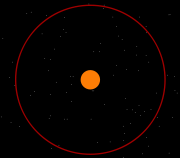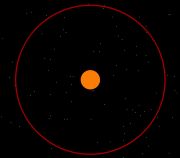米蘭科維奇循環
米蘭科維奇循環(Milankovich cycles),一個地球氣候變動的集合影響。以十萬年為主要周期,伴隨
著四萬年以及二萬年左右的周期。與三種地球繞日運行軌道的變化有關。這三個影響因素也造成了地球
的冰期與間冰期,大都與太陽輻射變化量有關。
運行軌道的三個變化
1.地球公轉軌道離心率的變化
為一個約九萬六千年的 周期。其間地球的軌道皆在圓形與橢圓形之間變化
。軌道離心率越小(越接近圓形)時,四季變化相對較不明顯,也不易有冰期的發生。反之, 離心率越接
近1(但不等於)的軌道,四季明顯,也較易產生冰期。
2.地球自轉軸傾斜角度的變化
地球 自轉軸的傾斜角度介於21.5度到24.5度之間,以四萬一千年為周期。
角度越大,高緯度地區因接受輻射的時間差異較大,易形成冰期。現今地球自轉軸傾斜角度為23.44度,
且有減少的跡象。
3.地球的歲差
因地球自轉軸的進動,造成一個大約兩萬六千年的周期。在 遠日點時,若北半球傾向太陽
,冬天溫度將會相對較高;若因進動而導致南半球在遠日點時傾向太陽,北半球的冬天將較為酷寒。又
因北半球陸地多,比熱小,溫度容易下降,而較容易形稱冰期。
但, 米蘭科維奇循環並未完全解釋氣候的變化,特別是冰期的產生,因為冰期的發生顯然小於十萬年這
個周期。
上述三種因素會集合影響地球的氣溫變化,例:當地球在遠日點且繞日運行的軌道離心率趨近於1,地球
自轉軸傾斜角度為最大的24.5度,且南半球傾向太陽,將可能發生極低溫的情形。此三個因素交錯影響
著地球氣溫,每個因素不同的表現也讓地球的氣溫更加不可預測。
<英文>Milankovitch cycles are the collective effect of changes in the Earth's movements upon its climate, named after Serbian civil engineer and mathematician Milutin Milanković. The eccentricity, axial tilt, and precession of the Earth's orbit vary in several patterns, resulting in 100,000-year ice age cycles of the Quaternary glaciation over the last few million years. The Earth's axis completes one full cycle of precession approximately every 26,000 years. At the same time, the elliptical orbit rotates, more slowly, leading to a 21,000-year cycle between the seasons and the orbit. In addition, the angle between Earth's rotational axis and the normal to the plane of its orbit moves from 22.1 degrees to 24.5 degrees and back again on a 41,000-year cycle. Currently, this angle is 23.44 degrees and is decreasing.
Earth’smovements
As the Earth spins around its axis and orbits around the Sun, several quasi-periodic variations occur. Although the curves have a large number of sinusoidal components, a few components are dominant. Milankovitch studied changes in the eccentricity, obliquity, and precession of Earth's movements. Such changes in movement and orientation change the amount and location of solar radiation reaching the Earth. This is known as solar forcing (an example of radiative forcing). Changes near the north polar area are considered important due to the large amount of land, which reacts to such changes more quickly than the oceans do.
Orbital shape (eccentricity) 軌道形狀(偏心率)
 正常的形狀
正常的形狀The Earth's orbit is an ellipse. The eccentricity is a measure of the departure of this
ellipse from circularity. The shape of the Earth's orbit varies from being nearly circular (low eccentricity of 0.005) to being mildly elliptical (high eccentricity of 0.058) and has a mean eccentricity of 0.028. The major component of these variations occurs on a period of 413,000 years (eccentricity variation of ±0.012). A number of other terms vary between 95,000 and 136,000 years, and loosely combine into a 100,000-year cycle (variation of −0.03 to +0.02). The present eccentricity is 0.017.
If the Earth were the only planet orbiting our Sun, the eccentricity of its orbit would not vary in time. The Earth's eccentricity varies primarily due to interactions with the gravitational fields of Jupiter and Saturn. As the eccentricity of the orbit evolves, the semi-major axis of the orbital ellipse remains unchanged. From the perspective of the perturbation theory used in celestial mechanics to compute the evolution of the orbit, the semi-major axis is an adiabatic invariant. According to Kepler's third law the period of the orbit is determined by the semi-major axis. It follows that the Earth's orbital period, the length of a sidereal year, also remains unchanged as the orbit evolves.
Currently the difference between closest approach to the Sun (perihelion) and furthest distance (aphelion) is only 3.4% (5.1 million km). This difference is equivalent to about a 6.8% change in incoming solar radiation. Perihelion presently occurs around January 3, while aphelion is around July 4. When the orbit is at its most elliptical, the amount of solar radiation at perihelion is about 23% greater than at aphelion. This difference is roughly 4 times the value of the eccentricity.
Season (Northern Hemisphere) Durations
Year Date: GMT Season Duration
2005 Winter Solstice 12/21/2005 18:35 88.99 days
2006 Spring Equinox 3/20/2006 18:26 92.75 days
2006 Summer Solstice 6/21/2006 12:26 93.65 days
2006 Autumn Equinox 9/23/2006 4:03 89.85 days
2006 Winter Solstice 12/22/2006 0:22 88.99 days
2007 Spring Equinox 3/21/2007 0:07沒被記錄
本資料來自http://aa.usno.navy.mil
Orbital mechanics require that the length of the seasons be proportional to the areas of the seasonal quadrants, so when the eccentricity is extreme, the seasons on the far side of the orbit can be substantially longer in duration. When autumn and winter occur at closest approach, as is the case currently in the northern hemisphere, the earth is moving at its maximum velocity and therefore autumn and winter are slightly shorter than spring and summer. Thus, summer in the northern hemisphere is 4.66 days longer than winter and spring is 2.9 days longer than autumn.
 米蘭科維奇循環
米蘭科維奇循環
